Diagnosis is positive for plant, insect clinic's new space
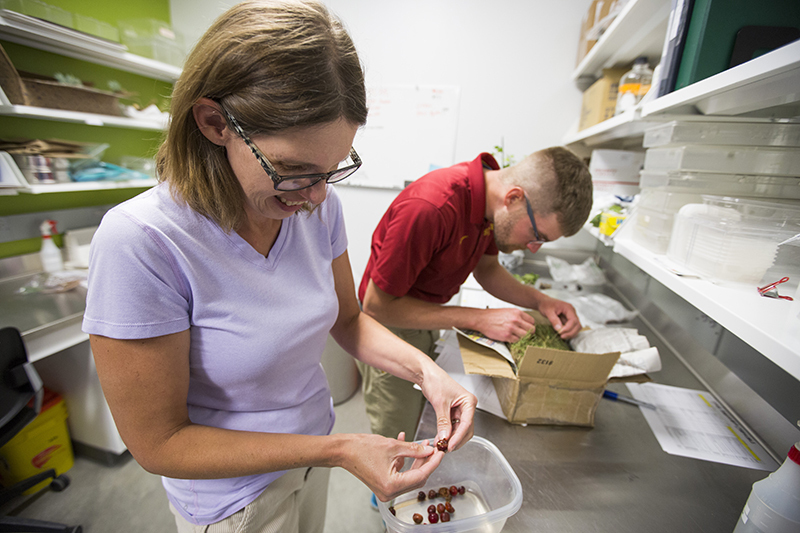
Laura Iles, left, and Ed Zaworski examine plant samples in the intake area of the Plant and Insect Diagnostic Clinic in the Advanced Teaching and Research Building. Photos by Christopher Gannon.
Yes, Laura Iles' team of diagnosticians at the Plant and Insect Diagnostic Clinic spend the bulk of their time studying nonhuman problems. But their jobs really are about helping people, said Iles, the clinic's director.
Their clientele are growers, crop scouts, landscapers, gardeners, county extension agents, homeowners -- any Iowan with a plant disease or pest concern. The clinic's recommendations for managing plant pathogens and unwanted insects are typically focused on prevention, which can require some garden bedside manner in cases of ailing specimens with special significance -- a tree planted as a memorial for a loved one, for instance.
"That's a hard conversation to have. People really have an emotional connection to the plants in their yards," Iles said. "And then, of course, the farmers have a lot of money on the line."
Taking root in new home
With the clinic's move in May to its new home in the Advanced Teaching and Research Building, those occasionally difficult discussions haven't gotten any easier. But day-to-day operations in the clinic are much improved, as is its public accessibility. Clients dropping off samples can drive directly to the building. Previously, the clinic was in Bessey Hall.
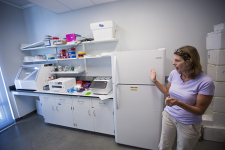
Director Laura Iles inside a lab room at the Plant and Insect Diagnostic Clinic.
"Now they don't have to talk themselves through the Osborn Drive gate," Iles said.
Inside the new, larger space are separate rooms for receiving and examining samples, growing bacterial cultures and conducting tests. Isolating "dirty" and "clean" rooms was an important upgrade from the prior single-room setup, especially for a lab geared toward public interaction, Iles said.
Plants as patients
The new facility opens as the clinic's caseload is on the rise. Last year, it processed nearly 2,600 samples, the most in about 15 years. Three diagnosticians -- including Iles, an entomologist -- are assisted by a handful of undergraduates in detecting and suggesting treatment and management options for diseases and insects that damage plants. They also survey crop and turfgrass soil samples for nematodes (roundworms) and identify unknown plants, insects and mushrooms.
"A tomato is lovely because we can get the whole sample," Iles said while pointing to a recently received tomato plant that included the root ball and surrounding soil. "When people have a dying tree, they can't send us the whole tree."The first step upon receiving a sample is triage. While the clinic aims for a turnaround time of less than two weeks, urgent requests move to the front of the line. That includes immediate health concerns, such as possible bedbugs or a tick found embedded in skin, Iles said. Submissions are documented thoroughly, including any observations or photos provided by the client. Anything could end up being a clue.
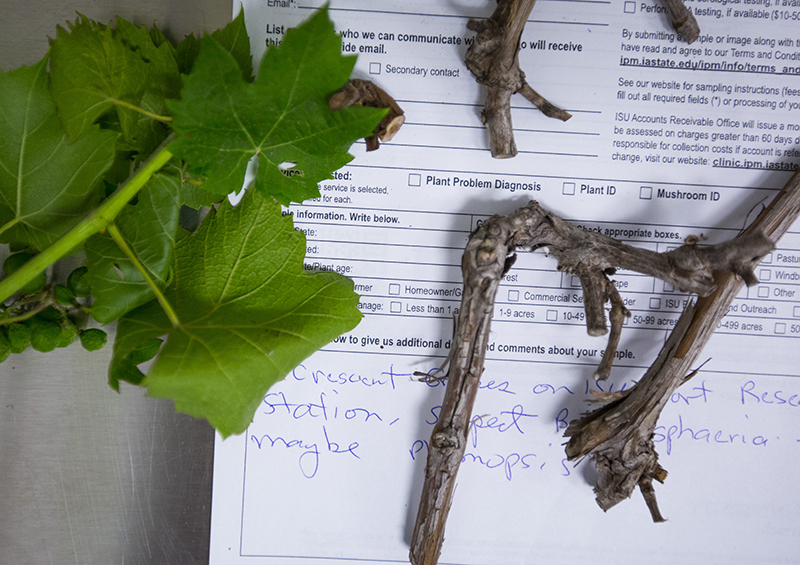
A submission to the Plant and Insect Diagnostic Clinic.
The issues the team deals with vary wildly. In 2017, 49 percent of diagnoses were plant disease, 29 percent were insect damage, 13 percent were environmental factors and 9 percent were identifications. Sometimes they can spot the problem from a photo. Or they may need to make bacterial cultures and run DNA tests. Often, they consult with Iowa State faculty with specific expertise. Once in a while, they get stumped.
"I always joke plants can't talk. We don't have a blood test for plants. That 'don't know' happens a lot," Iles said. "People envision we're like 'CSI' and can do a DNA test over the commercial break."
Ever-changing concerns
The clinic was established in the 1950s in response to Dutch elm disease, using faculty and graduate students to handle cases before the first full-time staffer was hired in 1989. Some diseases are constants -- Rhizosphaera needle cast on spruce trees, for instance -- but every year can bring new challenges, said Ed Zaworski, one of the clinic's two plant pathology diagnosticians, along with Lina Rodriguez-Salamanca.
In 2016, the emerging threat was bacterial leaf streak on corn, one of Zaworski's favorite set of cases he's worked on at the clinic. The disease was new to Iowa and could be confused with some lookalikes, he said. The clinic identified 336 instances of it that year.
"We were at that forefront of processing samples for the state," Zaworski said. "It was important."
Simply relaying common tips can be satisfying, too. Iles said learning straightforward facts about the bugs seeking refuge in their homes often settles down concerned homeowners.
"Those are the best days because people are so nice and so happy to have basic information. People don't know that much about insects, and it can be very upsetting," she said.
Expect detours, delays during RAGBRAI stopover in Ames
RAGBRAI revelry on campus
Iowa State units are hosting public activities and events as part RAGBRAI's stop in Ames.
University Boulevard. South Dakota Avenue. Mortensen Road. Beach Avenue. South Fourth Street. Sixth Street. If any of these roads are part of your daily drive to work, you may be better off getting there by bike on July 24.
Thousands of riders will roll into Ames Tuesday for an overnight stay following day three of the 2018 Register's Annual Great Bicycle Ride Across Iowa (RAGBRAI). Bikers are expected to begin arriving by 10 a.m. and continue to pour into town throughout the day on Tuesday, with the heaviest traffic between noon and 4 p.m.
Drivers should plan ahead for closures, detours and delays in and around Ames most of Tuesday and early Wednesday morning. Maps with route details, events and official RAGBRAI locations are available on the Ames RAGBRAI website. A video released last week also illustrates the route and closures.
Tuesday influx
Some areas along Tuesday's RAGBRAI route will be accessible to local residents only. Access to the Ames/ISU Ice Arena and Hansen Agriculture Student Learning Center also will be restricted. Cyride will announce temporary detours online. Commuter parking at the Iowa State Center will be limited to lots A1, B3, B4 and B5, and the transit stop will move to Center Drive (south of Stephens Auditorium).
Most July 24 road closures are anticipated to last from 8 a.m. to 6 p.m., with the exception of South Fourth Street and Sixth Street. Closures include:
- South Dakota Avenue/County Road R38 (from 270th Street to Mortensen Road)
- Highway 30 off-ramp, westbound exit 144 (South Dakota Avenue)
- Mortensen Road (from Pinon Drive to Hayward Avenue)
- Beach Avenue, northbound only
- South Fourth Street (from Beach Avenue to University Boulevard, 7 p.m. July 23 to 10 p.m. July 24)
- Sixth Street (from University Boulevard to Brookridge Avenue, 6 a.m. July 24 to 11 a.m. July 25)
Vehicles may be stopped for bike traffic at these controlled intersections:
- State Avenue/Mortensen Road
- University Boulevard/South Fourth Street
- University Boulevard/Lincoln Way
- University Boulevard/Sixth Street
Support vehicles, vendors and visitors also will be headed to designated RAGBRAI locations. Watch for bikers, pedestrians and shuttles traveling to and from the welcome and parking areas (South Fourth Street, Iowa State Center lots), campgrounds (Brookside Park, Stuart Smith Park, grass fields/lots east and south of Jack Trice Stadium) and entertainment venues (Main Street).
Farewell route
On Wednesday, July 25, RAGBRAI riders will mount up and head east, most before 8 a.m. No streets or intersections will be closed, but drivers are encouraged to avoid the RAGBRAI route out of town. Vehicles may be stopped at controlled intersections to allow bicycle traffic to cross.
Roads to avoid, especially in the early morning hours:
- University Boulevard (southbound, from Sixth Street to South 16th Street)
- South 16th Street (eastbound, from University Boulevard to Dayton Avenue)
- Dayton Avenue (northbound, from Southeast 16th Street to East Lincoln Way)
Vehicles may be stopped for bike traffic at these controlled intersections:
- University Boulevard/Sixth Street
- University Boulevard/Lincoln Way
- University Boulevard/South Fourth Street
- University Boulevard/South 16th Street
- South 16th Street/Duff Avenue
- Southeast 16th Street/Dayton Avenue
- Dayton Avenue/East Lincoln Way
University dedicates Ugandan training center
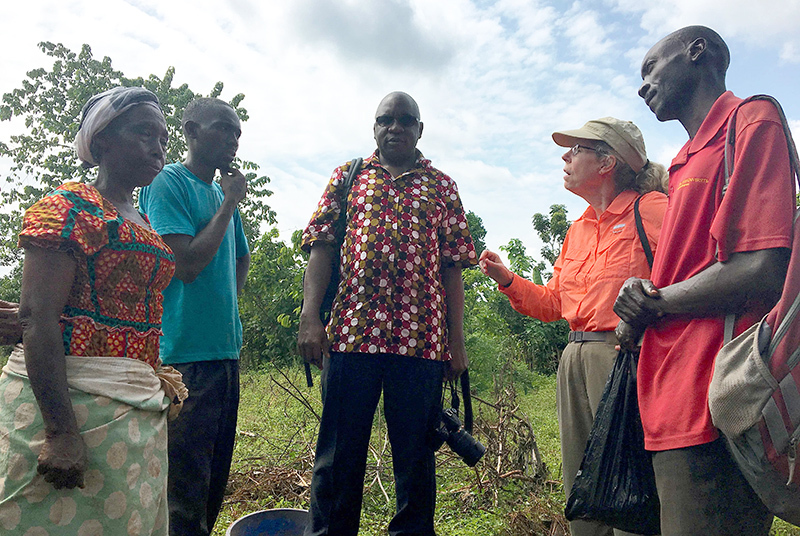
President Wendy Wintersteen (second from right) and Donald Kugonza, associate professor of animal science at Makerere University (center), visit with a local livestock farmer and her son (left) during a visit to Uganda's Kamuli district. Photos by Brian Meyer.
A new rural training center dedicated July 11 in the East African country of Uganda will help the Center for Sustainable Rural Livelihoods expand food and agricultural programs that serve local families. It also will provide more service-learning opportunities for ISU and African students.
"The Mpirigiti Rural Training Center epitomizes what can happen when donor support and Iowa State's land-grant mission unite through a passionate, compassionate vision for change and progress," said President Wendy Wintersteen, who spoke at the dedication.
The facility is the latest milestone in the 14-year history of the Center for Sustainable Rural Livelihoods, which has become a model for university international ag education programs and an inspiration for students to address global hunger and poverty. The ISU center has impacted thousands of lives through programs that help rural Ugandans gain skills in farming practices, nutrition, sanitation, and income-generating and entrepreneurial opportunities.
The $2.7 million Mpirigiti ("Em-pir-i-GIT-ee") Rural Training Center will be an education and training focal point for farmers, teachers, community leaders and students. Nearly 100 donors made it possible, with the office of the senior vice president and provost also providing support.
More than 80 people took part in the July 11 dedication, including:
- Faculty, staff and administrators from the College of Agriculture and Life Sciences (CALS) and its Ugandan partner, Makerere University
- Staff in ISU's Uganda Program, a nongovernmental organization established in 2015 to facilitate operations in the country
- Donors to the facility
- 36 Iowa State and Makerere service-learning students and interns
Features of the training facility
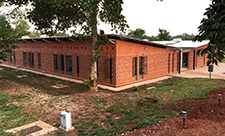
The student dormitory at the Mpirigiti training center can house 48 interns and students.
The 22,000-square-foot training center, which officially opened in March, sits on 13 acres. The main building has offices for the 20 ISU Uganda Program field staff who work in community nutrition, agronomy, land use, livestock, post-harvest technologies, youth entrepreneurship, school gardens and service learning. It also contains a library, meeting spaces, kitchen and dining area.
The complex has a 48-bed student dormitory; rooms for visiting faculty and guests; and demonstration areas for livestock and crop production, grain handling and agroforestry. A soccer field is open to the community and a basketball court will be constructed soon.
Local architects, engineers, contractors and labor constructed the facility. Local materials also were used, including 30,000 compressed earth blocks and locally sourced furniture and furnishings. Gardens and orchards supply fresh produce to students and visitors.
"The design was guided by green principles. We planned the facility to reduce our carbon footprint as much as possible," said David Acker, CALS associate dean for academic and global programs, who oversaw the training center's planning and development.
The facility conserves water by collecting and using rainwater. Wastewater is recycled using an anaerobic biodigester and constructed wetlands. A water purification system reduces the need for bottled water. Solar water heaters provide hot water, and photovoltaic panels generate power. Natural ventilation, ceiling fans and shade trees preclude the need for air conditioning.
Hub for learning
Since 2006, more than 250 Iowa State and Makerere students have participated in service learning in Uganda's Kamuli district. Over the years, students lived in 11 scattered locations.
"It always was a dream to have all the service-learners living together in one location. Now it's a reality," said Gail Nonnecke, associate director for education programs for the Center for Sustainable Rural Livelihoods, and a University Professor, Morrill Professor and Global Professor in Global Resource Systems.
This summer, the service-learners lived in the training center dorm and worked in teams with children both in school and out of school, farmers and families. Their projects emphasized agroforestry, beekeeping, school gardens, post-harvest handling, poultry production and school health/sanitation.
In the Lusoga language, "mpirigiti" is the name of a native tree highly prized for its healing and medicinal properties.
"When Ugandans see and hear the name of the training center, it will convey the concepts of health and wellbeing, both high priorities for the work of the Center for Sustainable Rural Livelihoods," Acker said.
Last year, service-learning students successfully dug up and moved a 25-foot mpirigiti tree in the path of construction. The tree survived and today shows new shoots and leaves. This year, a young mpirigiti tree was planted near the main building in honor of Acker's leadership and dedication to the project.
Iowa State attracts record external funding for fourth consecutive year
Iowa State attracted a record $509.2 million in total external funding for the fiscal year that ended June 30.
That's an increase of $5.6 million (1.1 percent) over fiscal year 2017's total of $503.6 million. Last year was the first time Iowa State broke the half-billion mark in external funding.
Fiscal year 2018's total marks the fourth record year in a row for Iowa State external funding.
External funding includes grants, contracts, gifts and cooperative agreements from federal, state and local governments as well as from corporations, nonprofits and other universities for research, academic support, scholarships and more.
"Record external funding for the fourth consecutive year reflects Iowa State University's role as a leader in academic and research excellence," said President Wendy Wintersteen. "We are proud of the exceptional return on this investment exemplified by our well-prepared graduates, economic opportunities and innovations that ensure a better future for Iowa and the world."
The latest fiscal year includes $245.8 million in external support for Iowa State researchers. That's a jump in research support of $2.1 million over fiscal year 2017. The record for research funding was $252.5 million during fiscal year 2016.
"We are pleased that our sponsors invest so strongly in Iowa State's research all over campus," said Sarah Nusser, vice president for research. "Our researchers have excelled in demonstrating the value of their discoveries and their capacity to create innovative solutions for today's challenges."
Nusser noted that federally supported research funding increased by $1.6 million over fiscal year 2017, to $170.3 million. That growth included funding increases from the National Institutes of Health and the Defense and Transportation departments.
Nusser also said early career researchers successfully competed for federal support – particularly 14 who won National Science Foundation CAREER awards during the latest fiscal year. The grants are the foundation's most prestigious awards for early career faculty.
Major sources of external research funding, FY18
|
Federal sources |
|
|
Energy (including Ames Laboratory) |
$59.5 million |
|
National Science Foundation |
$34.8 million |
|
Agriculture |
$32.3 million |
|
Health and Human Services |
$14.6 million |
|
Defense |
$9.8 million |
|
Commerce |
$8.5 million |
|
Transportation |
$5.1 million |
|
Non-federal sources |
|
|
Industry/corporate |
$21.7 million |
|
State of Iowa |
$18.2 million |
|
Nonprofits |
$16.2 million |
|
Higher education |
$11.2 million |
|
Commodity groups |
$5.1 million |
|
Individuals |
$0.97 million |
|
Total (includes many other sources) |
$509.2 million |
Recent history of external funding totals
- FY18, $509.2 million
- FY17, $503.6 million
- FY16, $425.8 million
- FY15, $424.9 million
- FY14, $368.4 million
- FY13, $326.4 million
- FY12, $360.2 million
- FY11, $342.3 million
- FY10, $388.2 million
Faculty applicants sought for new facility director
The office of the senior vice president and provost seeks applications from faculty interested in serving as the inaugural director of the Student Innovation Center, currently under construction. The director will provide overall leadership, vision and direction for the facility, including planning and implementing academic programming. The director also will foster engagement with students and external stakeholders.
This is an internal search open to current senior lecturers, adjunct associate professors, adjunct professors, associate professors and professors. The date for guaranteed consideration has been extended to Aug. 5. The Student Innovation Center director will report to the college deans of Engineering and Design.
Interested faculty may view the job posting for more information.
RAGBRAI revelry on campus
Expect detours, delays during RAGBRAI stopover in Ames
Road closures and controlled intersections may slow your commute July 24-25.
Although the city of Ames is the host for Tuesday's RAGBRAI stop, Iowa State is a partner for the event. Incorporated into the "Cycling Power: Taking the State by Storm" theme for the event, Iowa State will host the welcome site and several camping and parking locations for RAGBRAI participants.
The Cycling Power welcome rally on South Fourth Street is free and open to the public. It includes an optional "Cyclone Loop," giving bikers a chance to take a lap around the field in Jack Trice Stadium. Vendors -- including university units -- will have displays, merchandise, food and beverages in the welcome area, with pep rallies scheduled on the hour from 1 to 3 p.m.

Reiman Gardens will have live music and on-site vendors offering food and beverages from noon to 6 p.m. Tuesday. RAGBRAI riders receive a $2 discount off general admission (regularly $9, or $8 for seniors).
Tuesday evening, visitors are invited to central campus for the third guest performance of this summer's carillon concert series. Ray McLellan, university carillonneur at Michigan State University, Lansing, will perform a six-song program at 7 p.m. Lawn chairs, blankets and bikes are welcome at the free concert.
Get involved
Volunteers still are needed at various locations. Position descriptions and available shifts are available online. Community members also can host RAGBRAI riders in or at their homes -- from parking spaces, to available beds, to yard space for tent camping.

